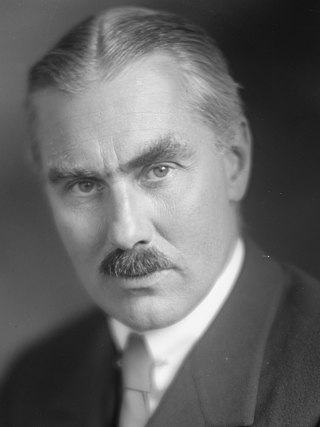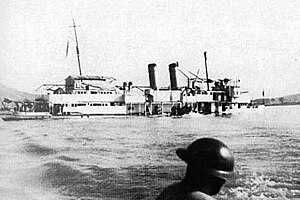
The United States Asiatic Fleet was a fleet of the United States Navy during much of the first half of the 20th century. Before World War II, the fleet patrolled the Philippine Islands. Much of the fleet was destroyed by the Japanese by February 1942, after which it was dissolved, and the remnants incorporated into the naval component of the South West Pacific Area command, which eventually became the Seventh Fleet.

USS Edsall (DD-219), was a Clemson-class destroyer, the first of two United States Navy ships named after Seaman Norman Eckley Edsall (1873–1899). She was sunk by a combined Japanese air and sea attack, approximately 200 miles east of Christmas Island on 1 March 1942.

The Asiatic Squadron was a squadron of United States Navy warships stationed in East Asia during the latter half of the 19th century. It was created in 1868 when the East India Squadron was disbanded. Vessels of the squadron were primarily involved in matters relating to American commerce with China and Japan, though it participated in several conflicts over 34 years of service until becoming the Asiatic Fleet in 1902.

Joseph Clark Grew was an American career diplomat and Foreign Service officer. He is best known as the ambassador to Japan from 1932 to 1941 and as a high official in the State Department in Washington from 1944 to 1945. He opposed American hardliners, sought to avoid war, and helped to ensure the soft Japanese surrender in 1945 that enabled a peaceful American occupation of Japan after the war.

The second USS Panay (PR–5) of the United States Navy was a Panay-class river gunboat that served on the Yangtze Patrol in China until being sunk by Japanese aircraft on 12 December 1937 on the Yangtze River.

USS Queenfish (SS/AGSS-393), was a Balao-class submarine, the first ship of the United States Navy to be named for the queenfish, a small food fish found off the Pacific coast of North America.

The Yangtze Patrol, also known as the Yangtze River Patrol Force, Yangtze River Patrol, YangPat, and ComYangPat, was a prolonged naval operation from 1854 to 1949 to protect American interests in the Yangtze River's treaty ports. The Yangtze Patrol also patrolled the coastal waters of China where they protected U.S. citizens, their property, and Christian missionaries.

The Nanking Incident occurred in March 1927 during the capture of Nanjing by the National Revolutionary Army (NRA) in their Northern Expedition. Foreign warships bombarded the city to defend foreign residents against rioting and looting. Several ships were involved in the engagement, including vessels of the Royal Navy and the United States Navy. Marines and sailors were also landed for rescue operations including some 140 Dutch forces. Both Nationalist and Communist soldiers within the NRA participated in the rioting and looting of foreign-owned property in Nanjing.

The fourth USS Preble (DD-345/DM-20/AG-99) was a United States Navy Clemson-class destroyerin commission from 1920 to 1945. She served in China, including on the Yangtze Patrol, and later saw combat in World War II as a minelayer. She was named for Commodore Edward Preble.

Luigi Barzini Jr. was an Italian journalist, writer and politician most famous for his 1964 book The Italians, delving deeply into the Italian national character and introducing many English and German speaking readers to Italian life and culture.

USS Tutuila (PR-4) was a gunboat in the service of the United States Navy from 1928, until her transfer to China, under lend-lease in 1942.

John Henry Lang (1899–1970) was an American who served with the Canadian Army in World War I and then with the United States Navy through World War II and the end of his career. He earned military awards and honors for heroic service from the United Kingdom, the United States, and Japan in the first half of the twentieth century.

A hell ship is a ship with extremely inhumane living conditions or with a reputation for cruelty among the crew. It now generally refers to the ships used by the Imperial Japanese Navy and Imperial Japanese Army to transport Allied prisoners of war (POWs) and rōmusha out of the Philippines, the Dutch East Indies, Hong Kong and Singapore in World War II. These POWs were taken to the Japanese Islands, Formosa, Manchukuo, Korea, the Moluccas, Sumatra, Burma, or Siam to be used as forced labor.

USS Finch (AM-9) was a Lapwing-class minesweeper acquired by the U.S. Navy for the dangerous task of removing mines from minefields laid in the water to prevent ships from passing. Finch was named for the finch, and is strictly speaking the only U.S. vessel named for such.

The Commander-in-Chief, China, was the admiral in command of what was usually known as the China Station, at once both a British Royal Navy naval formation and its admiral in command. It was created in 1865 and deactivated in 1941.

The first USS Oahu (PR-6), a Yangtze River gunboat, was laid down by Kiangnan Dock and Engineering Works, Shanghai, China, 18 December 1926; launched as PG–46 on 26 November 1927; sponsored by Mrs. Bryson Bruce, wife of Comdr. Bruce; and commissioned 22 October 1928, Lt. Comdr. A. C. Thomas in command.

The first USS Luzon (PG-47) was laid down 20 November 1926 by the Kiangnan Dock and Engineering Works, Shanghai, China; launched 12 September 1927; sponsored by Miss Mary C. Carter, daughter of Commander Andrew F. Carter, USN; and commissioned 1 June 1928.
HMS Peterel was a river gunboat built by Yarrow Shipbuilders at Scotstoun and she was the sixth ship of the Royal Navy to carry the name. Her name used an archaic spelling for consistency with previous Royal Navy Ships of the same name, in contrast to the modern accepted spelling petrel.

Naval Station Pearl Harbor is a United States naval base on the island of Oahu, Hawaii. In 2010, as part of the recommendations of the Base Realignment and Closure (BRAC) commission, the naval station was consolidated with the United States Air Force's Hickam Air Force Base to form Joint Base Pearl Harbor–Hickam. Since 1940, Pearl Harbor has been the headquarters of the United States Pacific Fleet.

SS Rakuyo Maru (楽洋丸) was a passenger cargo ship built in 1921 by the Mitsubishi Shipbuilding & Engineering Company, Nagasaki for Nippon Yusen Kisen Kaisha.























